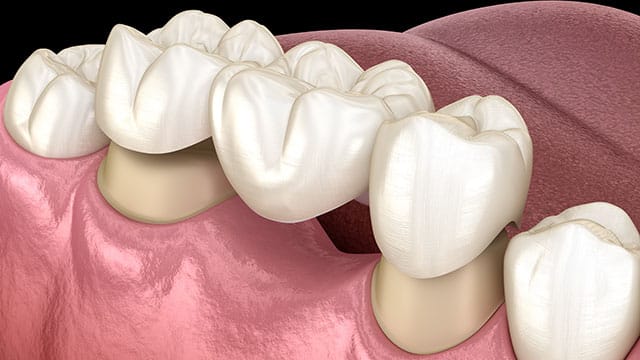If you have one or more missing teeth, your dental professional may recommend that you get artificial replacements. There are removable options like dentures that you can take out and clean, but those can slide around, shift, or fall out – which understandably won't fly for many people. And that's why there are crowns affixed to dental implants and bridges which function more like your actual teeth. But between crown implants and bridges, which option is the best choice for you? We'll break down the similarities, differences, advantages, and disadvantages between these two fixed artificial tooth options so that even if you have a fake tooth or two, you'll have a smile that's as real as can be.

What’s the Difference Between Dental Crowns and Tooth Bridges?
Medically Reviewed By Colgate Global Scientific Communications
What's the Difference Between Dental Crowns and Dental Bridges?
A dental crown can cap an individual's damaged or decaying tooth or be placed on top of a dental implant to replace a missing tooth. Dental implants are metal fixtures, surgically fastened to your jawbone below the gums. These metal implants become anchored to your bone through osseointegration (the bone fuses to the metal). This process provides stable support you can rely on while eating and speaking. According to the Cleveland Clinic, the healing process after getting an implant can take 6-12 weeks. Your dental professional will then place a metal post (or abutment) into your implant, onto which they will mount your crown.
Bridges, on the other hand, are solely used to replace missing teeth. They have two crowns – one on either end – and a bridge of replacement teeth that rest in the area of the gums where there is tooth loss. The crowns at the ends of a bridge can fuse to existing teeth (that need to be filed down by a dental professional to fit correctly), or your dental professional can attach them to dental implants.
Whichever of these replacement tooth options is best for you – they can be vital in maintaining your oral health. Gaps in areas of loss can cause your other teeth to begin rotating or shifting into the empty spaces, resulting in a bad bite. And missing teeth can even lead to gum disease and temporomandibular joint (TMJ) disorders.
How do Crowns Work?
When a crown caps a damaged, weak, or decaying tooth, it's generally to help maintain its size, strength, shape, and appearance. If you're missing a tooth, a dental professional will give you a dental implant, on top of which they will place your crown. The American Academy of Implant Dentistry says that 3 million Americans have dental implants, and that number is growing by 500,000 every year.
Your crown will be made from one, or a mixture, of various materials. Gold alloy and other metal alloy options tend to be durable and cost-effective, but they won't look much like your other teeth. Porcelain, acrylic, and ceramic crowns can more closely match your natural teeth. Acrylic and ceramic options are known to be durable. Porcelain is a bit more prone to chipping and damage, but porcelain bonded to a metal shell can increase its strength while maintaining its attractive tooth-like aesthetic.
Learn about the four different types of dental crowns.
How do Bridges Work?
Whereas crowns can repair damaged teeth, a bridge's sole function is to replace one or more missing teeth. For a bridge, your dental professional will place caps on filed-down teeth or dental implants at the outer edges of your area of loss. Replacement teeth (called pontics) span the space between the caps where the teeth are missing.
Just like with dental crowns, you have a choice of materials available to you for your bridge. Your dental professional is in the best position to advise you in your material choice base on your individual needs. However, you'll both want to consider and discuss multiple factors like the visibility of the tooth, the cost, the strength, and how it looks.
How are Crowns Made?
If you're getting a crown for a damaged or decayed tooth, your dental professional will make an impression of your bite. From that model, they will be able to determine the best shape for your new tooth. Often, the model for your bite needs to be sent to a lab where they will create your crown, which can take a few weeks. Some dental offices can make crowns in their offices depending on the material you choose and whether they have the required equipment. If your dental professional has CAD/CAM (Computer-Aided Drafting/Computer-Aided Manufacturing) capabilities and you're capping an existing, damaged tooth, you could get your crown in a single dental visit.
How are Bridges Made?
Before your dental professional can have your bridge made, the teeth at the outer edges of the area of loss will be reduced in size so that your bridge will fit on them properly – unless, of course, they place the bridge on implants. Like with a crown, your dental professional will then take an impression to provide an exact mold for the bridge.
Using this impression, your dental office will either create your bridge in-office or send the model to a dental lab. Your dental professional will use temporary crowns or bridges to cover the prepared teeth while the lab makes your bridge.
How Long do Crowns and Bridges Last?
Sometimes crowns and bridges can become loose or fall out from the damage caused by chewing hard foods, ice, or other hard objects. Dental disease that causes tooth or bone loss is another reason crowns or bridges may loosen over time.
By practicing good oral hygiene, however, crowns and bridges can last a lifetime. Brush at least twice a day, floss or clean between your teeth with interdental brushes or water flossers at least once a day, and consider using other helpful products like antimicrobial mouth rinses and tongue scrapers. Be sure to see your dental professional for regular cleanings – not only to keep your teeth pearly white and bacteria-free but also to check the health of your crown or your bridge. Whether you and your dentist decide on a crown or a bridge for your replacements, we hope your new teeth make you smile.
This article is intended to promote understanding of and knowledge about general oral health topics. It is not intended to be a substitute for professional advice, diagnosis or treatment. Always seek the advice of your dentist or other qualified healthcare provider with any questions you may have regarding a medical condition or treatment.







